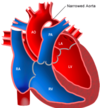S3) Congenital Heart Defects Flashcards
What is hypoplastic left heart syndrome?
Hypoplastic left heart syndrome (HLHS) is a rare congenital heart defect in which the left heart is severely underdeveloped resulting in inadequate right to left flow in utero

The exact cause of Hypoplastic left heart syndrome is unknown.
However, identify 2 possible causes
- Defect in development of mitral and aortic valves, resulting in atresia and limited flow
- Ostium secundum too small

Identify 5 different kinds of atrial septal defects which might occur

Describe ventricular septation in terms of the 2 components of the ventricular septum
- Muscular portion forms most of the septum and grows upwards towards the fused endocardial cushions
- Small gap - primary interventricular foramen
- Membranous portion of the IV septum derived from endocardial cushions to “fill the gap”

What is Tetralogy of Fallot?
Tetralogy of Fallot is a group of 4 abnormalities occurring together as the result of a single developmental defect which places the outflow portion of the interventricular septum too far in the anterior and cephalad directions:
Mnemonic: Pulmonary stenosis, Overriding aorta, ventricular Septal defect, right ventricular Hypertrophy

Explain why Tetralogy of the Fallot presents with cyanosis
- Increased pressure on the right side of the heart, VSD and overriding aorta allows right to left shunting
- Deoxygenated blood mixes with oxygenated blood, resulting in cyanosis
What is an ASD?
An atrial septal defect (ASD) is an opening in the septum/wall between the two atria which persists following birth

Why are ASD’s not life-threatening?
- Left atrial pressure > right atrial pressure
- Flow is from left ⇒ right
- Deoxygenated blood does not mix with the oxygenated blood
Describe the ostium secundum atrial septal defect
Ostium secundum atrial septal defect occurs when the ostium secundum fails to close completely while the heart is developing, causing an opening to develop in the centre of the wall separating the two atria

What is a patent foramen ovale?
A patent foramen ovale is a condition when the foramen ovale doesn’t close and persists after birth

PFOs may be present in around 20% of the population.
Provide 2 reasons as to why this often clinically silent?
- Higher left atrial pressure causes functional closure of the flap valve
- No symptoms/complications, hence, not a concern unless you have other heart conditions
What is a VSD?
A ventricular septal defect (VSD) is an abnormal opening in the interventricular septum, commonly occurring in the membranous portion of the septum

Describe blood flow in the case of a VSD
- Left ventricular pressure > right ventricular pressure so blood will flow from left to right
- The amount of flow depending on the size of the lesion
Explain the effects of a left to right shunt
Although left to right shunting of blood does not cause cyanosis it can be problematic later on if untreated, with the extent of the problems depending on the degree of shunting
Describe what occurs in transposition of the great vessels
- Transposition of the great arteries results in two unconnected parallel circulations instead of two circulations in series
- In this defect the right ventricle is connected to the aorta and the left ventricle to the pulmonary trunk

Briefly, state the effect and treatment of transposition of the great vessels
A baby with transposed arteries is cyanotic and requires immediate surgical intervention
Describe the functional importance of tricuspid atresia
- Tricuspid atresia (lack of development of the tricuspid valve) leaves no inlet to the right ventricle
- Hence, there must be a complete right to left shunt of all the blood returning to the right atrium (ASD/PFO) and a VSD/PDA to allow blood flow to the lungs

What is the ductus arteriosus?
The ductus arteriosus is a vessel that exists in the foetus to shunt blood from the pulmonary artery to the aorta before the lungs are functioning
What is a patent ductus arteriosus and how does it occur?
- The ductus arteriosus should close shortly after birth as the pressure in the pulmonary artery drops following perfusion of the lungs
- Failure to close leads to a patent ductus arteriosus and blood flows from aorta to pulmonary arteries

What is coarctation of the aorta?
Coarctation of the aorta: a narrowing of the aortic lumen in the region of the ligamentum arteriosum (former ductus arteriosus)

Explain the pathophysiology of coarctation of the aorta
- The narrowing of the aorta increases the afterload and can lead to LV hypertrophy
- Vessels to the head and upper limbs emerge proximal to the coarctation, so blood supply is not compromised but is reduced in rest of body
Where is a common location for coarctation of the aorta?
The coarctation typically occurs after the left subclavian artery (ligamentum arteriosum)
Identify 2 symptoms of coarctation of the aorta
- Hypertension in the upper extremities
- Hypotension in the lower extremities


